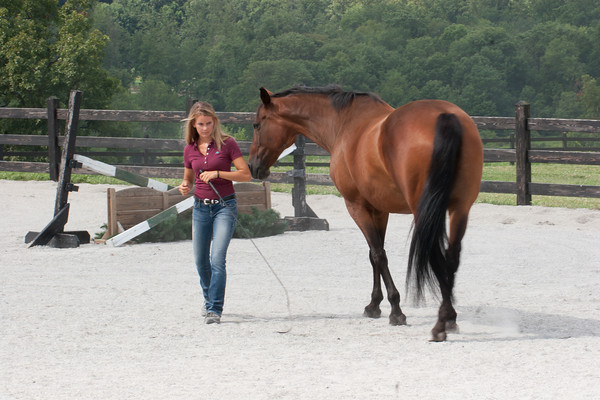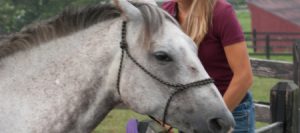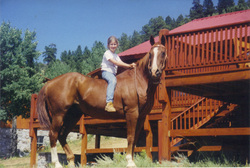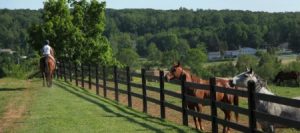 What is good horsemanship? Is it an art, completely reliant on a person’s innate skill, intuitive understanding, and natural feel? Or can horsemanship also be examined and understood through a scientific lens as well?
What is good horsemanship? Is it an art, completely reliant on a person’s innate skill, intuitive understanding, and natural feel? Or can horsemanship also be examined and understood through a scientific lens as well?
What I have been discovering recently is that horsemanship, not unlike many other aspects of life, is best looked at as part art and part science. The art involves such things as “feel,” perfecting timing, and being able to tap into one’s intuition when working with horses on the ground or mounted. The art of horsemanship, to me, is also the control of our emotions and the knowledge of how the energy systems within our own bodies interact with those of our horses.
I do believe, however, that horsemanship at its best is more than art. As an article in an older addition of The Veterinary Journal put it, “ideally, equestrian technique combines art and science.” So what is the science of horsemanship? It is the science of behavior and the application of learning theory. Our interactions with horses are much more beneficial when we understand what drives and motivates our horses behaviors. Training becomes much easier when we pause to think about how to best convey our intended message to our horses. Science also helps us understand the physiology of correct training for the horse and biomechanics for the rider; as well as allows us to develop healthier nutrition, better fitting saddles, and improved medical care for our horses.
The art of horsemanship is not easy to teach, it involves practice, developing one’s instincts with horses, and even finding a higher degree of emotional control for ourselves as horses are so easily affected by our own mental state of being. I often wonder if this is why some great horseman, who are a joy to watch with their horses, have trouble explaining what it is they actually do to get their amazing results. They can give us exercises to try at home with our horses, but the actual details of what makes them so successful are hard to articulate. It’s their art, and it’s difficult to explain, just as Da Vinci couldn’t teach us to paint a Mona Lisa.
The science of behavior and of learning theory is a different story though, that is easy to teach and easy to learn. With a solid foundation in knowledge of these subjects, then we can perfect the art of horsemanship; the subtleties of reading a horse’s behavior and the emotion behind it or the perfect timing to apply inside leg and outside rein. In addition, I have increasingly found that the principles of learning theory – involving associative and non-associative learning, as well as classical and operant conditioning, apply perfectly to horse training, and just by understanding these principles, our training techniques, and therefore our horsemanship, can improve.
Another key benefit of science in horsemanship is that it can help us understand why some modern training techniques are lacking in their theory. As was also stated in the same article I mentioned earlier from The Veterinary Journal, “traditional horse training aimed to develop horses that were so compliant they would lose all sense of self-preservation. Horses were expected to be submissive to the commands of a rider, and blame for failure to conform fell on the horse.” This approach may have been necessary to produce war horses, but today it can create dangerous conflict behaviors such as bucking or rearing or it can create a horse that is sometimes referred to as “shut down,” or displaying a condition known as “learned helplessness.” This is a physiological condition where a horse learns they have no control over unpleasant conditions and their actions to change their situation are futile (C. Hall).
Fortunately, science has given us better ways to work with our horses, and has made it easier to understand horses really learn and how we can best communicate with them. For example, by using techniques that employ positive reinforcement, we can engage and motivate our horses so that they become active and willing participants in their training.
There is an old saying, “when the student is ready, the teacher will appear” and this has certainly rang true for me in many instances. The issue of bringing more science into my own training is no exception. Thanks to a friend at my barn, I have recently discovered two organizations that are promoting better horsemanship through science. The work being done by researchers in these organizations is shedding light on the inadequacies of “traditional” training, as well as demystifying some (but not all) of the art in horsemanship. These organizations are the International Society for Equitation Science (ISES) and the International Association of Animal Behavior Consultants (IAABC). I am sure there are other organizations and individuals out there in this field as well, and I applaud their work! I am excited to become more involved in these communities and learn all that my equine teachers have in store for me, whether it falls under art or science!
If you want to read another article I wrote this week about a similar topic, called “What My Dog Taught Me About Horse Training” you can do so here: http://www.horsenation.com/2014/03/21/what-my-dog-taught-me-about-horse-training/
Resources for this post:
McGreevy, Paul D. “The Advent of Equitation Science” The Veterinary Journal 174 (2007) 492-500.
Hall, C., Goodwin, D., Heleski, C., Randle, H., Waran, N., “Is There Evidence of Learned Helplessness in Horses” Proceedings of the 3rd International Equitation Science Conference 2007 http://eprints.soton.ac.uk/63515/1/Proceedings_of_the_3rd_International_Equitation_Science_Conference_2007[1].pdf
International Society for Equitation Science http://www.equitationscience.com/
International Association of Animal Behavior Consultants https://iaabc.org/
Also, just wanted to say a quick thank you to my friend Jen, who scours the web for fascinating people and good articles and forwards them to me 🙂














2 Responses
As a novice rider, I greatly appreciated this article! I have so much to fundamentally learn, but I also hope me own artistry will grow with my horse as the years go by. thanks for your insights!
Thank you, Callie, for reminding us that no matter what we know (or think we know OR would like to know), there is always more to learn and that, indeed, the ultimate teacher is the horse!!